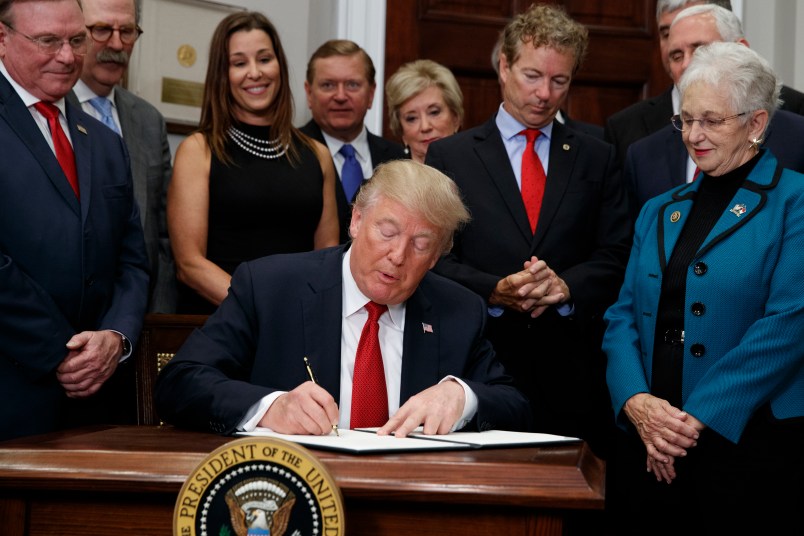It’s hard to predict the effect of an executive order aimed at undermining Obamacare that President Trump signed Thursday, as the order was vague and left most of the details to the relevant departments writing the regulations.
But there’s at least one claim Trump made during the signing ceremony that probably won’t pan out: “This will cost the United States government virtually nothing,” he promised, while vowing people “will have great, great health care.”
Such a claim is at odds with the stated goals of the order and how it would affect government spending related to the Affordable Care Act.
The key dynamic is that as the Trump administration seeks to make it easier for young, healthy people to access non-Obamacare compliant plans, the premiums for the sicker people left in ACA exchanges will rise. And for a vast majority of those enrollees, the government will be on the tab for paying that increase, due to the Obamacare tax credits that are pegged to growth in premiums.
“Effectively by reducing the number of healthy people in the marketplaces, you’re increasing the liability for federal taxpayers to pick up more of the cost of that premium,” said Sabrina Corlette, a researcher at Georgetown University’s Health Policy Institute.
The order directs relevant agencies to consider rewriting regulations related to three major issues: health association plans, short-term limited duration insurance, and health savings accounts.
It’s hard to know exactly how the months-long rule-making process will shake out, but the general goal is to make it easier for people to buy plans that don’t have to meet “very expansive and expensive Obamacare coverage mandates and rules,” as Trump put it Thursday.
For instance, Trump is directing his administration to allow people to use short term insurance for longer than the three months allowed by Obama-era regulations.
“The real effect of this executive order depends almost entirely on the details in regulations that are yet to come,” Larry Levitt, vice president at Kaiser Family Foundation, said in an email to TPM. “But there’s no question the order could have an effect on government costs. If short-term insurance plans expand, they’ll cherry pick healthy people and leave a sicker pool of people in the ACA marketplace. Premiums in marketplace plans would rise, and government subsidies would rise as well, since they’re tied to premiums.”
The White House seems to acknowledge the effect on premiums — and how the tax credits will have to rise with them — in a fact sheet obtained by The Hill.
“Nearly nine-in-ten people with an exchange plan receive premium tax credits and will largely be unaffected by this EO,” it said. “People who receive tax credits are insulated from bearing the cost of the higher premium since the credit limits the amount of income they pay for a benchmark plan.”
The other main areas of the order could exacerbate this trend. If individuals are allowed to participate in health association plans, the premiums in the ACA exchanges stand to become more expensive for reasons akin to the effort to expand short term insurance. (The order, however, only mentions business’ ability to access the association health plans, which would allow employers to band with similar businesses across state lines to create their own policies.)
Even the push to expand health savings accounts may cause premiums to rise, according to Timothy Jost, a health care law specialist at Washington and Lee University. That could incentivize “large employers to dump unhealthy people into the exchanges,” he said, with the similar effect of making the risk pool more costly for insurers to cover.
Unlike the various legislative Obamacare repeal proposals, we don’t have a Congressional Budget Office score to analyze the order’s cost to government. However, a CBO score of what would happen if Trump stopped paying certain subsidies to insurers — which would have a similar effect of raising premiums, if by different means — shows how such measures end up being costly to the government. That move, and the 25 percent hike in premiums it would cause, would add nearly $200 billion to the deficit over the next 10 years, the CBO found.
Jost warned, however, that the executive order’s short-term cost to the government could come with long-term chaos that could send insurers fleeing from the marketplaces, significantly shrinking the total Obamacare enrollment.
“In the long run, they hope [it] will have the effect of destroying the market altogether,” Jost said.











The Republicans have made it clear that they want people to die.
So the steaming pile of crap that is our leader finds yet another way to sabotage the ACA, trying again to undo ANYTHING that President Obama accomplished. He is a petulant little baby, lashing out at anything and can’t handle that a black man was better than him. I pray for his demise and hope he dies in prison from some wasting long lasting painful disease. I want him to suffer for years.
Well, you know the classic words written by the great Scottish novelist Sir Walter Scott:
"Oh, what a tangled web we weave,
When first we practice to be the biggest motherfucking asshole that you could possibly believe."
Thank you Ms Sneed. The article points out the multiple negative variables. As I said elsewhere, Trump’s health plan throwouts of “would be better” and “not cost us anything” has never been true in the history of man, or of Trump.
This guy does not understand basic physics. Shit rolls downhill.
Hang them all in the post-Trump Tribunal trials.